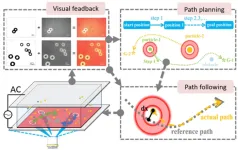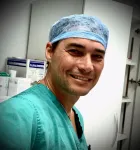(Press-News.org) COLUMBUS, Ohio – Nuclear physicists have found a way to peer inside the deepest recesses of atomic nuclei, according to a new study.
The finding was made possible using the Relativistic Heavy Ion Collider (RHIC) at the Brookhaven National Laboratory in New York, which is capable of colliding gold ions at near light-speed. It led to the discovery of a new kind of quantum entanglement.
The term quantum entanglement describes an invisible link that connects distant objects; no matter how far away they are in space, they affect each other. That means if two particles are entangled on a quantum level, by measuring the quantum state of one of the particles, you can immediately know the quantum state of the other, wherever it may be. For example, using a coin analogy, if one particle is “heads,” scientists instantly discern that the other particle is “tails,” no matter where in the universe it is.
Theoretical physicist Albert Einstein once dismissed the phenomenon of quantum entanglement as “spooky action at a distance,” but Daniel Brandenburg, co-author of the study and a professor of physics at The Ohio State University, said that learning more about this codependent relationship is fundamental to understanding the mysteries of the world around us.
“Entanglement is one of the defining characteristics that makes quantum mechanics so different from the kind of physics that normally happens around us,” he said.
The study of how photons and electrons interact with and affect matter, quantum mechanics is the foundation on which many technologies – such as quantum computing and quantum chemistry – are built. Despite these advancements, scientists previously believed that only particles of the same kind were capable of quantum interference: Photons could only interfere with photons and neutrons with neutrons. That is, until now.
This new study, published in the journal Science Advances, describes how a team of researchers – called the STAR Collaboration – used the RHIC to uncover a form of quantum entanglement that shows that particles of all different kinds are able to interact with one another, leading to interference in a variety of different patterns.
“We’ve gotten different kinds of particles to interfere for the first time, even though previously people thought that it wasn’t possible in quantum mechanics,” said Brandenburg. Using the collider like a large 3D digital camera, researchers used light to track the particles that escaped from the center of the machine once the atoms collided, taking high-resolution, two-dimensional images much like how a PET scan can be used to image and measure changes in the human body.
This method allowed researchers to map the arrangement of gluons – gluelike particles that act as a binding force for quarks, the particles within the protons and neutrons inside atomic nuclei. These interactions produced a subatomic particle called a pion that, by measuring the velocity and angles at which light struck the collider, researchers were able to essentially use as a microscope to see inside atomic nuclei in a way like never before.
“By playing these quantum mechanical tricks, we can get to a precision which shouldn’t be possible otherwise,” Brandenburg said. “This precision allowed us to actually see, within an individual gold nucleus, where the protons and the neutrons reside.”
This novel result was in part made thanks to a discovery Brandenburg made about two years ago, called the Breit-Wheeler process, which details how light can be turned into matter and antimatter. Building on the physics of this previous discovery, the team was able to view inside the nucleus on a scale of a tenth to a hundredth the size of an individual proton.
“That’s mind-blowingly small,” said Brandenburg.
The findings could eventually help advance research in several fields, from quantum computing to astrophysics, he said.
Brandenburg, whose interest in nuclear physics originally began in astronomy, notes that because all matter is connected, investigating the inner workings of atomic nuclei could also allow astrophysicists to discern aspects like a star’s stability, its size, density, and even how it formed. “By doing this work here on Earth, we’re helping to actually understand better the things that are far out in the universe,” Brandenburg said.
Going forward, the team hopes to extend its work by mapping the depths of other kinds of quantum objects.
“One of the big questions in our field is how do we understand the properties of this fundamental building block of matter,” he said. “With the discovery of this new type of entanglement, we can start to test these ideas for the first time.”
This work was supported by the Office of Nuclear Physics within the U.S. Department of Energy Office of Science, the U.S. National Science Foundation, the National Natural Science Foundation of China, and others.
#
Daniel Brandenburg, Brandenburg.89@osu.edu
Tatyana Woodall, Woodall.52@osu.ed
END
Why is "junk DNA" not deleted from the original genome over millions of years of evolution?
A new model offers an explanation for the huge variety of sizes of DNA in nature
Unlike "junk email" that is immediately deleted from the email box, "junk DNA" continues to exist in living creatures in nature such as bacteria, insects, and even mammals such as humans, alongside the original genome and thus the genome grows throughout evolution.
The researchers' explanation: the "junk DNA" hides in functional areas, thus deletions are likely to damage the functional ...
San Antonio – Feb. 22, 2023 – Southwest Research Institute and ITS Texas are inviting college students and young professionals to participate in the inaugural Future Leaders Program at the 2023 ITS America Conference & Expo April 24-27 in Grapevine, Texas.
The new program is designed to inspire the next generation of leaders in the intelligent transportation systems (ITS) industry through a variety of activities at the ITS America Conference & Expo, which takes place this year at the Gaylord Texan Resort. Participants can attend education sessions and training and network with ITS professionals, exhibitors, sponsors and technology providers.
“The ...
A research paper by scientists at the Beijing Institute of Technology proposed an automated manipulation method for transporting microparticles actuated by optoelectronic tweezers (OETS).
The new research paper, published in the journal Cyborg and Bionic Systems, developed a dynamic control framework for synchronously discretized manipulation of multiple microparticles. Differentiated motion decisions are formulated for each micro target based on the corresponding state and environmental information in real time, so that all controlled targets can reach their goal positions safely and accurately. The motion of microparticle is controlled through dynamic modulation ...
New research from the University of Missouri School of Medicine has established a link between irritable bowel syndrome (IBS) and mental health challenges, such as anxiety, depression, and suicidal ideation. The research highlights the need for health professionals to evaluate and treat associated psychiatric co-morbidities in IBS patients to improve their overall health and quality of life.
IBS is a chronic disorder of the stomach and intestines affecting up to 15 percent of the population. It causes cramping, abdominal pain, bloating, gas, and diarrhea. This study looked at more than 1.2 million IBS patient hospitalizations from 4,000 U.S. hospitals over a three-year ...
Mistletoe extract has been widely used to support cancer therapy and improve quality of life, but there has been a lack of clinical trials and data to support its use. Researchers at the Johns Hopkins Kimmel Cancer Center completed what is believed to be the first phase I trial of intravenous Helixor M in the U.S. aimed at determining dosing for subsequent clinical trials and to evaluate safety.
The findings from the small study were reported online Feb. 9 in Cancer Research Communications.
The trial’s ...
PATERSON, N.J.—The first-ever casebook on ultrasound-guided vascular access procedures offers practical solutions to complex bedside challenges with an emphasis on improving patient safety. Now available from Springer Publishing, the casebook features 50 chapters highlighting clinical challenges and evidence-based solutions for everything from peripheral to tunneled central lines in neonatal, pediatric, and adult patient populations.
Ultrasound-Guided Vascular Access: Practical Solutions to Bedside Clinical Challenges is coauthored by vascular access expert Matthew D. Ostroff, MSN, APN, and world-renowned cardiac surgeon Mark Connolly, MD, ...
Like an old man suddenly aware the world has moved on without him, the conifer tree native to lower elevations of California’s Sierra Nevada mountain range finds itself in an unrecognizable climate. A new Stanford-led study reveals that about a fifth of all Sierra Nevada conifer forests – emblems of Western wilderness – are a “mismatch” for their regions’ warming weather. The paper, to be published Feb. 28 in PNAS Nexus, highlights how such “zombie forests” are temporarily cheating death, likely to be replaced with tree species ...
Researchers from Boston College, Georgetown University, American University, Texas A&M University, and Colorado State University published a new Journal of Marketing article that challenges the entrenched belief that financial vulnerability only affects low-income consumers.
The study, forthcoming in the Journal of Marketing, is titled “Beyond Income: Dynamic Consumer Financial Vulnerability” and is authored by Linda Court Salisbury, Gergana Y. Nenkov, Simon J. Blanchard, Ronald Paul Hill, Alexander L. Brown, and Kelly D. Martin.
Even pre-pandemic, many U.S. workers lived ...
For his contributions to the field of regeneration, Alejandro Sánchez Alvarado receives the Vilcek Prize in Biomedical Science. The Vilcek Prize in Biomedical Science is a $100,000 prize awarded annually by the Vilcek Foundation as part of its prizes program.
Awarded annually since 2006, the Vilcek Foundation prizes recognize and celebrate immigrant contributions to scientific research and discovery, and to artistic and cultural advancement in the United States. The prizes provide direct support to individual immigrant scientists and artists and help to raise greater public awareness of the value of immigration ...
People are occasionally exposed to potentially harmful substances in the environment or through their diets or habits. For example, a compound found in cigarette and industrial smoke, benzo(a)pyrene (BaP), is known to damage DNA. Now, researchers reporting in ACS Central Science have mapped these effects — down to the single-nucleotide level — for the first time in human lung cells after BaP exposure. They say that this technique could help predict exposures that lead to cancers.
When BaP gets into a person’s body and is metabolized, it can turn into a new compound, or metabolite, that irreversibly attaches to one ...



